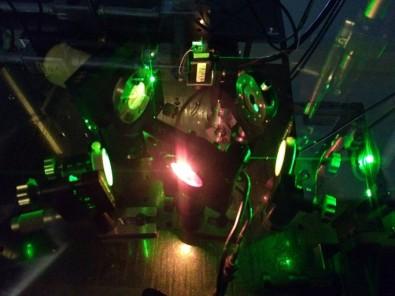Potential applications of research conducted at the University of São Paulo include high-precision metrology and information encoding.

Credit: Marcelo Martinelli / IF-USP
The properties of quantum states of light are already leveraged by such highly sophisticated leading-edge technologies as those of the latest sensitivity upgrades to LIGO, the Laser Interferometer Gravitational-Wave Observatory, deployed to detect gravitational waves since September 2015, or the encryption keys used for satellite on-board security.
Both solutions use crystals as noise-free optical amplifiers. However, the use of atomic vapors has been considered a more efficient alternative that enhances the accessibility of non-classical light states.
“We show that oscillators based on these atomic amplifiers can generate intense beams of light with quantum correlations,” Marcelo Martinelli (https:/
Both crystals and atomic vapors can be used to produce quantum correlated pairs of light beams. Investigating the behavior of these sources is a challenge. The behavior of light below a certain level of power resembles that of the light produced by a bulb. Above a certain threshold, its characteristics are similar to those of a laser. “It’s as if the crystals or atomic vapor converted the light from a lamp into laser light. It’s easier to investigate this transition in the atomic medium than the crystalline medium since more intense beams can be produced in an atomic medium,” Martinelli said.
Optical cavities are used for this purpose. Controlling cavity geometry and atomic vapor temperature, Martinelli and collaborators were able to produce photon coupling in more open cavities.
“This offered two advantages in comparison with the old crystal-based cavities – more quantum efficiency so that the number of photons supplied by the output window easily surpassed the number of photons lost to the environment, and a chance to investigate more subtle details of the transition between light with heterogeneous frequencies and the production of intense laser-like beams. It was as if we had opened a window on to the quantum dynamics of the phase transition,” Martinelli said.
Potential applications include high-precision metrology with manipulation of the quantum noise in light and information encoding via quantum entanglement.
###
About São Paulo Research Foundation (FAPESP)
The São Paulo Research Foundation (FAPESP) is a public institution with the mission of supporting scientific research in all fields of knowledge by awarding scholarships, fellowships and grants to investigators linked with higher education and research institutions in the State of São Paulo, Brazil. FAPESP is aware that the very best research can only be done by working with the best researchers internationally. Therefore, it has established partnerships with funding agencies, higher education, private companies, and research organizations in other countries known for the quality of their research and has been encouraging scientists funded by its grants to further develop their international collaboration. You can learn more about FAPESP at http://www.
Media Contact
Heloisa Reinert
[email protected]
Original Source
https:/
Related Journal Article
http://dx.




